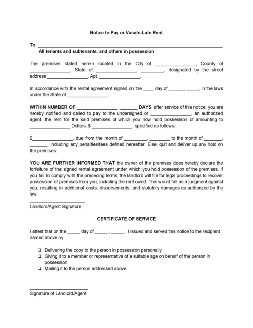- Eviction Notice Forms
- Power of Attorney Forms Forms
- Bill of Sale (Purchase Agreement) Forms
- Lease Agreement Forms
- Rental Application Forms
- Living Will Forms Forms
- Recommendation Letters Forms
- Resignation Letters Forms
- Release of Liability Agreement Forms
- Promissory Note Forms
- LLC Operating Agreement Forms
- Deed of Sale Forms
- Consent Form Forms
- Support Affidavit Forms
- Paternity Affidavit Forms
- Marital Affidavit Forms
- Financial Affidavit Forms
- Residential Affidavit Forms
- Affidavit of Identity Forms
- Affidavit of Title Forms
- Employment Affidavit Forms
- Affidavit of Loss Forms
- Gift Affidavit Forms
- Small Estate Affidavit Forms
- Service Affidavit Forms
- Heirship Affidavit Forms
- Survivorship Affidavit Forms
- Desistance Affidavit Forms
- Discrepancy Affidavit Forms
- Guardianship Affidavit Forms
- Undertaking Affidavit Forms
- General Affidavit Forms
- Affidavit of Death Forms
Notice to Pay or Vacate- Late Rent
Rental history is one of the factors that landlords look for a potential tenant. Rental history includes evictions, chronic late payments, disruptive behavior, and major property damage. The rental or lease agreement outlines the landlord-tenant relationship. As part of the process, landlords have to prepare a notice to pay or vacate for tenants who failed to deposit the rent for a period(s). Since there are many reasons why tenants delay their payments, landlords assure themselves and protect their assets with this formal notice. Read More
Notice to Pay or Vacate- Late Rent
What is a Notice to Pay or Vacate for Late Rental?
The notice to pay or vacate (notice to quit due to late rent) functions to inform the tenants about their nonpayment for a specified period. The number of days varies from state to state. For instance, in Arizona, it takes five (5) days compared to Alabama with seven (7) days. California with three (3) days while Massachusetts provides fourteen (14) days of notice for it. This type of notice allows tenants to gather funds to pay the due amount. If tenants make the payment within the time frame, their rent will be back to compliance. If not, will need to move out or possibly face an eviction suit perceived as a ‘forcible entry and detainer.’
How to Create a Notice to Pay or Quit for Minutes
There are lots of reasons why tenants fail to deposit a rental payment. That is why this one-page sheet notice allows landlords to protect their assets and, at the same time, offer considerations to tenants for them to pay the rent owed. Even though this notice is a short form, this should comprise all necessary parts. When writing this, landlords have to gain basic knowledge of each section. As a landlord, if you want to learn more about how you can create this type of notice, it would be better if you take time reading the steps and tips as follows.
1. Check on the Existing State Laws
As mentioned earlier, every state covers distinguished laws that outline the notice. As a result, you have to adjust your content on what the state law allows you to include. In some states, some statutes restrict the penalty amount that the landlord may charge. Some do not. Certain states also provide grace periods that enable a tenant to get an extension for payment. Some have no specified outline for it.
2. Start Drafting your Notice
Everything starts from scratch. Creating from scratch does not mean there is no use at all. Instead, it is a way of refining the necessary details to include. For your notice to pay or quit, you must identify the following information and incorporate them into your notice form.
(i) mention the information on the stated premises, including its address or with apartments; landlords may specify the apartment floor or room number.
(ii) identifies necessary information about the tenants and subtenants or anyone on hold for the position.
(ii) the sum of rent owed, including fees if there is any.
(iv) remit payment
(v) signature of the landlord or any authorized representatives
(vi) possible repercussions of the tenancy once the tenant did not respond and received timely.
3. Review the Entire Content
If you are done drafting your notice, you recheck every detail that you have. Once you have completed everything in one clean sheet, you may start putting each section in place. Make sure that the information stated in the second step has complete and accurate information about it.
4. Sign and Add a Certificate of Service
Lastly, you now sign the notice with the space provided at the bottom part of it. The signature verifies that the landlord or an authorized agent is the one sent for teamwork. Also, you provide a Certificate of Service and again vows to this transaction.
FAQs
Prior to how many days should I send a notice to pay or vacate to my tenants?
The number of days depends on the state you currently reside in. Other than the states mentioned above, Pennsylvania requires ten (10) days notice to pay or vacate (quit) for late rental, South and North Dakota with three (3) days notice, and Washington with 14 days of the same notice. If your state is unmentioned herein, you may search about it.
What happens after the notice period?
If the tenant received the notice, and after a few business days, he or she could not comply with it, the landlord may file for an eviction in the court. The court will issue a court date to discuss the matter further and decide about the filed eviction case.
Can eviction from the rental property be canceled?
In some cases, eviction can be canceled for two possible reasons. First, it depends on whether both parties (tenants and landlords) agreed to postpone the removal and settle with another date to take effect. Second, the court has the power to cancel the eviction once proven that the action does not comply with existing and applicable laws.
